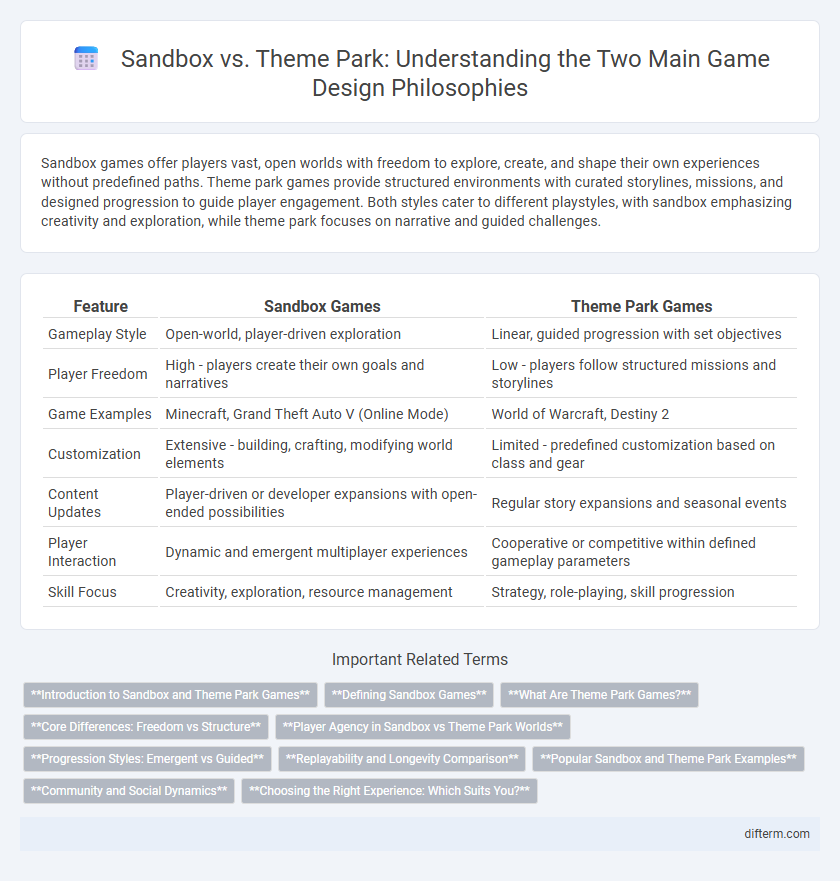Sandbox games offer players vast, open worlds with freedom to explore, create, and shape their own experiences without predefined paths. Theme park games provide structured environments with curated storylines, missions, and designed progression to guide player engagement. Both styles cater to different playstyles, with sandbox emphasizing creativity and exploration, while theme park focuses on narrative and guided challenges.
Table of Comparison
| Feature | Sandbox Games | Theme Park Games |
|---|---|---|
| Gameplay Style | Open-world, player-driven exploration | Linear, guided progression with set objectives |
| Player Freedom | High - players create their own goals and narratives | Low - players follow structured missions and storylines |
| Game Examples | Minecraft, Grand Theft Auto V (Online Mode) | World of Warcraft, Destiny 2 |
| Customization | Extensive - building, crafting, modifying world elements | Limited - predefined customization based on class and gear |
| Content Updates | Player-driven or developer expansions with open-ended possibilities | Regular story expansions and seasonal events |
| Player Interaction | Dynamic and emergent multiplayer experiences | Cooperative or competitive within defined gameplay parameters |
| Skill Focus | Creativity, exploration, resource management | Strategy, role-playing, skill progression |
Introduction to Sandbox and Theme Park Games
Sandbox games provide players with open-world environments and non-linear gameplay, encouraging exploration and creativity by allowing them to shape the game world freely. Theme park games offer structured experiences with guided narratives, fixed quests, and clearly defined objectives, resembling a curated amusement park ride. Popular examples include Minecraft for sandbox and World of Warcraft for theme park styles, illustrating the contrast between player-driven freedom and developer-driven storytelling.
Defining Sandbox Games
Sandbox games provide players with open-ended environments that encourage exploration, creativity, and player-driven objectives, offering freedom to interact with the game world without rigid constraints. These games emphasize user agency, allowing customization, building, and emergent gameplay, in contrast to predefined storylines or missions. Popular examples of sandbox games include Minecraft, Grand Theft Auto, and Terraria, showcasing diverse approaches to player freedom and environmental interaction.
What Are Theme Park Games?
Theme park games feature structured gameplay with predefined quests, storylines, and environments designed to guide players through specific experiences. They emphasize curated content, narrative progression, and clear objectives, often resembling a linear or semi-linear path. Popular examples include World of Warcraft and Final Fantasy XIV, where players follow set missions within detailed, immersive worlds.
Core Differences: Freedom vs Structure
Sandbox games offer players extensive freedom, enabling open-world exploration and creative problem-solving without preset objectives, exemplified by titles like Minecraft and Grand Theft Auto. Theme park games provide structured experiences with carefully designed levels and scripted missions, guiding players through a narrative or set challenges as seen in games like World of Warcraft and Call of Duty. The core difference lies in player agency: sandbox games prioritize autonomy and emergent gameplay, while theme park games focus on curated storylines and controlled progression.
Player Agency in Sandbox vs Theme Park Worlds
Player agency in sandbox worlds is characterized by open-ended gameplay, allowing players to explore, create, and influence the game environment with minimal restrictions. Theme park worlds provide structured narratives and guided experiences, limiting player choices to curated paths and predefined outcomes. The difference in player agency fundamentally shapes the game's replayability, level of immersion, and personalization of the gaming experience.
Progression Styles: Emergent vs Guided
Sandbox games emphasize emergent progression, allowing players to explore open worlds and create unique experiences without strict objectives. Theme park games feature guided progression, offering structured quests and narrative-driven content that directs player advancement. Emergent styles foster creativity and player-driven goals, while guided progression ensures a cohesive story and balanced rewards.
Replayability and Longevity Comparison
Sandbox games excel in replayability and longevity due to their open-world design and player-driven experiences, allowing countless unique playthroughs and creative freedom. Theme park games offer structured content and curated narratives, resulting in a more finite but highly polished experience that can become repetitive over time. Players seeking lasting engagement typically favor sandbox titles for dynamic gameplay and continuous content evolution.
Popular Sandbox and Theme Park Examples
Popular sandbox games like Minecraft, Grand Theft Auto V, and Skyrim offer open-world experiences with player-driven exploration and creativity. In contrast, theme park games such as World of Warcraft, Destiny 2, and The Elder Scrolls Online emphasize structured storylines, guided quests, and multiplayer interaction within designed environments. Both genres attract millions, with sandbox titles praised for freedom and theme park games favored for narrative depth and cooperative gameplay.
Community and Social Dynamics
Sandbox games foster dynamic player-driven communities by enabling open-ended exploration and creativity, encouraging collaboration and emergent social interactions. Theme park games structure social dynamics through curated quests and events, promoting shared experiences within a controlled narrative framework. The contrast influences how players form alliances, compete, and engage socially, with sandbox environments offering more fluid and player-generated social roles.
Choosing the Right Experience: Which Suits You?
Sandbox games offer open-world freedom, allowing players to explore, create, and dictate their own pace, making them ideal for those who value creativity and non-linear gameplay. Theme park games provide structured storylines, curated quests, and guided progression, perfect for players seeking immersive narratives and clear objectives. Understanding whether you prefer unrestricted exploration or a well-defined gaming pathway helps in choosing the right experience tailored to your playstyle.
sandbox vs theme park Infographic

 difterm.com
difterm.com